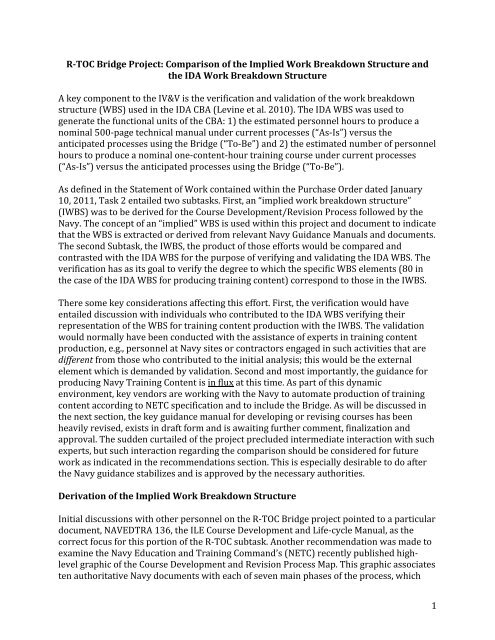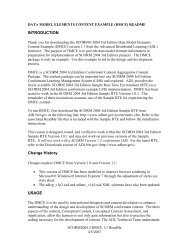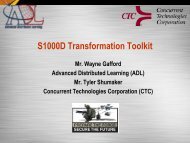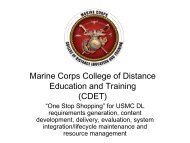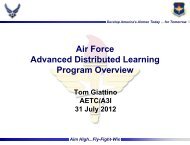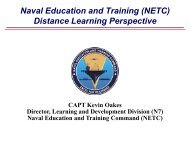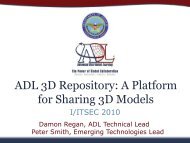Comparison of the Implied Work Breakdown Structure - ADL
Comparison of the Implied Work Breakdown Structure - ADL
Comparison of the Implied Work Breakdown Structure - ADL
Create successful ePaper yourself
Turn your PDF publications into a flip-book with our unique Google optimized e-Paper software.
R-TOC Bridge Project: <strong>Comparison</strong> <strong>of</strong> <strong>the</strong> <strong>Implied</strong> <strong>Work</strong> <strong>Breakdown</strong> <strong>Structure</strong> and<br />
<strong>the</strong> IDA <strong>Work</strong> <strong>Breakdown</strong> <strong>Structure</strong><br />
A key component to <strong>the</strong> IV&V is <strong>the</strong> verification and validation <strong>of</strong> <strong>the</strong> work breakdown<br />
structure (WBS) used in <strong>the</strong> IDA CBA (Levine et al. 2010). The IDA WBS was used to<br />
generate <strong>the</strong> functional units <strong>of</strong> <strong>the</strong> CBA: 1) <strong>the</strong> estimated personnel hours to produce a<br />
nominal 500-‐page technical manual under current processes (“As-‐Is”) versus <strong>the</strong><br />
anticipated processes using <strong>the</strong> Bridge (“To-‐Be”) and 2) <strong>the</strong> estimated number <strong>of</strong> personnel<br />
hours to produce a nominal one-‐content-‐hour training course under current processes<br />
(“As-‐Is”) versus <strong>the</strong> anticipated processes using <strong>the</strong> Bridge (“To-‐Be”).<br />
As defined in <strong>the</strong> Statement <strong>of</strong> <strong>Work</strong> contained within <strong>the</strong> Purchase Order dated January<br />
10, 2011, Task 2 entailed two subtasks. First, an “implied work breakdown structure”<br />
(IWBS) was to be derived for <strong>the</strong> Course Development/Revision Process followed by <strong>the</strong><br />
Navy. The concept <strong>of</strong> an “implied” WBS is used within this project and document to indicate<br />
that <strong>the</strong> WBS is extracted or derived from relevant Navy Guidance Manuals and documents.<br />
The second Subtask, <strong>the</strong> IWBS, <strong>the</strong> product <strong>of</strong> those efforts would be compared and<br />
contrasted with <strong>the</strong> IDA WBS for <strong>the</strong> purpose <strong>of</strong> verifying and validating <strong>the</strong> IDA WBS. The<br />
verification has as its goal to verify <strong>the</strong> degree to which <strong>the</strong> specific WBS elements (80 in<br />
<strong>the</strong> case <strong>of</strong> <strong>the</strong> IDA WBS for producing training content) correspond to those in <strong>the</strong> IWBS.<br />
There some key considerations affecting this effort. First, <strong>the</strong> verification would have<br />
entailed discussion with individuals who contributed to <strong>the</strong> IDA WBS verifying <strong>the</strong>ir<br />
representation <strong>of</strong> <strong>the</strong> WBS for training content production with <strong>the</strong> IWBS. The validation<br />
would normally have been conducted with <strong>the</strong> assistance <strong>of</strong> experts in training content<br />
production, e.g., personnel at Navy sites or contractors engaged in such activities that are<br />
different from those who contributed to <strong>the</strong> initial analysis; this would be <strong>the</strong> external<br />
element which is demanded by validation. Second and most importantly, <strong>the</strong> guidance for<br />
producing Navy Training Content is in flux at this time. As part <strong>of</strong> this dynamic<br />
environment, key vendors are working with <strong>the</strong> Navy to automate production <strong>of</strong> training<br />
content according to NETC specification and to include <strong>the</strong> Bridge. As will be discussed in<br />
<strong>the</strong> next section, <strong>the</strong> key guidance manual for developing or revising courses has been<br />
heavily revised, exists in draft form and is awaiting fur<strong>the</strong>r comment, finalization and<br />
approval. The sudden curtailed <strong>of</strong> <strong>the</strong> project precluded intermediate interaction with such<br />
experts, but such interaction regarding <strong>the</strong> comparison should be considered for future<br />
work as indicated in <strong>the</strong> recommendations section. This is especially desirable to do after<br />
<strong>the</strong> Navy guidance stabilizes and is approved by <strong>the</strong> necessary authorities.<br />
Derivation <strong>of</strong> <strong>the</strong> <strong>Implied</strong> <strong>Work</strong> <strong>Breakdown</strong> <strong>Structure</strong><br />
Initial discussions with o<strong>the</strong>r personnel on <strong>the</strong> R-‐TOC Bridge project pointed to a particular<br />
document, NAVEDTRA 136, <strong>the</strong> ILE Course Development and Life-‐cycle Manual, as <strong>the</strong><br />
correct focus for this portion <strong>of</strong> <strong>the</strong> R-‐TOC subtask. Ano<strong>the</strong>r recommendation was made to<br />
examine <strong>the</strong> Navy Education and Training Command’s (NETC) recently published high-‐<br />
level graphic <strong>of</strong> <strong>the</strong> Course Development and Revision Process Map. This graphic associates<br />
ten authoritative Navy documents with each <strong>of</strong> seven main phases <strong>of</strong> <strong>the</strong> process, which<br />
1
contain guidance and more detailed information for carrying out <strong>the</strong> processes. These ten<br />
documents, in turn reference additional documents. The graphic serves as <strong>the</strong> foundation<br />
for <strong>the</strong> more detailed work breakdown structure derived in this task (NETCINSTR-‐1500.9,<br />
2010). The portion <strong>of</strong> <strong>the</strong> diagram relevant to <strong>the</strong> study at hand is represented in Figure 1<br />
below.<br />
Figure 1. Course Development/Revision : End-‐to-‐End Process<br />
Unlike <strong>the</strong> original graphic, Figure 1 does not include <strong>the</strong> trigger event received by an<br />
external or internal requirement source that initiates <strong>the</strong> course development <strong>of</strong> revision<br />
process that was in <strong>the</strong> original graphic. Trigger events range from change in <strong>the</strong> Navy<br />
Mission Essential Task List to requirements sponsor changes, but <strong>the</strong>y are outside <strong>the</strong><br />
course development/revision process and so is not included in <strong>the</strong> IWBS. The process<br />
depicted in Figure 1 represents a standardized way to respond to such triggers and<br />
evaluate whe<strong>the</strong>r and how to develop or change content.<br />
Both according to NETC’s depiction <strong>of</strong> course development and revision in Figure 1 as well<br />
as personnel working on <strong>the</strong> R-‐TOC Bridge project, <strong>the</strong> NAVEDTRA 136 guidance manual<br />
was expected to serve as <strong>the</strong> sole authoritative source for defining <strong>the</strong> ILE course<br />
development and life-‐cycle maintenance WBS. According to <strong>the</strong> NAVEDTRA 136 manual,<br />
<strong>the</strong> “NETC Integrated Learning Environment Course Development and Life-‐Cycle<br />
Maintenance Manual provides direction for developing and maintaining instructor-‐led<br />
training, interactive multimedia instruction, and blended training materials for delivery<br />
using current technologies and best practices to enhance institutional and individual<br />
learning and performance support for <strong>the</strong> Navy's Total Force at home, schoolhouse, or<br />
afloat” (NAVEDTRA-‐136, 2010, pg iii). As such, using NAVEDTRA 136 one should be able to<br />
derive <strong>the</strong> ILT WBS.<br />
2
NAVEDTRA 136 defines seven phases or subprocesses comprising <strong>the</strong> Build New Course or<br />
Revise Existing Course process from Figure 1: Planning; Analysis; Design: Development;<br />
Implementation; Evaluation and Life-‐cycle Maintenance (mnemonically referred to as<br />
PADDIE+M). However, analysis <strong>of</strong> NAVEDTRA 136 indicates that <strong>the</strong> first five (5) phases<br />
depicted in Figure 1’s NETC Course Development/Revision : End-‐to-‐End Process (Conduct<br />
JDTA, Perform a Front-End Analysis, Perform Content Quality Review, Develop Business Case<br />
and Develop <strong>the</strong> Training Project Plan) are actually all part <strong>of</strong> <strong>the</strong> Planning subprocess <strong>of</strong><br />
<strong>the</strong> Build New or Revise Existing Course process ra<strong>the</strong>r than as being independent <strong>of</strong> and<br />
feeding into it. This interpretation is consistent with each <strong>of</strong> <strong>the</strong>se processes as producing<br />
Planning Phase outputs (see NAVEDTRA 136 Table 1, pg. 2-‐9). Finally this is consistent<br />
with <strong>the</strong> fact that <strong>the</strong> IDA WBS clearly includes as one <strong>of</strong> its earliest (2 nd ) task, Conduct JDTA<br />
(Job, Duty, Task Analysis). Figure 2 depicts <strong>the</strong> representation <strong>of</strong> <strong>the</strong> process flow if one<br />
follows NAVEDTRA 136.<br />
Figure 2. Graphic Combination <strong>of</strong> NETCNOTE 1500.9 (Figure 1) and <strong>the</strong> NAVEDTRA 136’s<br />
Definition <strong>of</strong> <strong>the</strong> Planning Phase<br />
The ramifications <strong>of</strong> this inconsistency are tw<strong>of</strong>old. First, eight Navy guidance documents<br />
had to be consulted ra<strong>the</strong>r than one (NAVEDTRA 136) to conduct this R-‐TOC Subtask and<br />
derive <strong>the</strong> IWBS. NAVEDTRA 130 and 131 series did not really figure into <strong>the</strong> analyses<br />
since <strong>the</strong>y focus content ra<strong>the</strong>r than process. The time required to review this several-‐fold<br />
increase in documentation was weighed against goals to accurately capture <strong>the</strong> IWBS.<br />
There may thus be WBS elements that were omitted. Fur<strong>the</strong>r examination <strong>of</strong> <strong>the</strong>se manuals<br />
may be warranted in future work.<br />
3
Second, although <strong>the</strong> accurate representation differs from that as NETC’s high level<br />
representation in Figure 1, <strong>the</strong> lowest level elements that are subject to cost estimation,<br />
called leaf nodes in <strong>the</strong> WBS, will remain <strong>the</strong> same (assuming consistency in <strong>the</strong> multiple<br />
task definitions across <strong>the</strong> many manuals), and not affect <strong>the</strong>ir usage in <strong>the</strong> cost analysis<br />
that might be conducted.<br />
Ano<strong>the</strong>r inconsistency between NETC’s rendition <strong>of</strong> course development and revision and<br />
NAVEDTRA 136 is that <strong>the</strong> latter included an additional process entitled here, Development<br />
Training Transition Plan. According to NAVEDTRA 136 and OPNAVINST 1500.76, this<br />
process should be carried out between <strong>the</strong> Front End Analysis and <strong>the</strong> process Develop<br />
Business Case. Based on its definition, <strong>the</strong> process Develop Training Transition Plan has<br />
been inserted before <strong>the</strong> process Perform Quality Evaluation Review.<br />
Finally, ano<strong>the</strong>r source <strong>of</strong> information was found: <strong>the</strong> Navy Training Development Plan<br />
Process Flow (Scribd, 2010). Unfortunately, this resource was delivered as a single diagram<br />
with no reference to source using SCRIBD, an on-‐line viewer. The process flow given,<br />
though, was likely interpreted from <strong>the</strong> Navy ILE Content Developer’s Handbook<br />
(MPT&ECIOSWIT-‐ILE-‐HDBK-‐1C, 2009). There are useful practical steps included in this<br />
process flow that would be necessary to take during actual development and implemen-‐<br />
tation <strong>of</strong> training content. NAVEDTRA 136 did not cite many <strong>of</strong> <strong>the</strong>se practical steps.<br />
Figure 3. Navy Training Development Plan Process Flow<br />
4
The <strong>Implied</strong> <strong>Work</strong> <strong>Breakdown</strong> <strong>Structure</strong><br />
The IWBS was initially constructed and documented as <strong>the</strong> guidance manuals were read<br />
using a free demonstration version <strong>of</strong> WBS Chart Pro Demo 4.8 1 . The analog Task List is<br />
generated simultaneously in MS Project as <strong>the</strong> WBS was created as a supposedly seamless<br />
feature between <strong>the</strong> two. In reality, any information inserted into <strong>the</strong> WBS Chart Pro text<br />
fields is lost in <strong>the</strong> “integration”. Similarly <strong>the</strong> notes field information in MS Project is not<br />
carried back to WBS Chart Pro. To adjust for this lack <strong>of</strong> functionality, <strong>the</strong> notes from <strong>the</strong><br />
WBS were manually copied to <strong>the</strong> “Notes” field associated with each task in <strong>the</strong> MS Project<br />
task list. This was fortuitous due to fur<strong>the</strong>r limitations to <strong>the</strong> WBS Chart Pro demo version.<br />
The demo version is limited to 50 tasks, which when reached prevents users from adding<br />
tasks and also denies access to <strong>the</strong> task definition object. For this reason, <strong>the</strong> remainder <strong>of</strong><br />
<strong>the</strong> WBS was codified in <strong>the</strong> MS Project task list exclusively. Beyond <strong>the</strong> 50 tasks,<br />
definitional information and references from <strong>the</strong> authoritative sources for each task were<br />
inserted into <strong>the</strong> notes section <strong>of</strong> each task in MS Project as consistently as possible. Figure<br />
4 shows how WBS Chart Pro represents Levels 0-‐1, with one task, Build New Course or<br />
Revise Existing Course, expanded to Level 2. The ability to collapse and expand at various<br />
levels facilitates construction <strong>of</strong> <strong>the</strong> WBS.<br />
Figure 4. Level 2 Depiction <strong>of</strong> <strong>the</strong> Course Development/Revision WBS<br />
Some Navy guidance documents referenced in NAVEDTRE 136 could not be located. For<br />
example, <strong>the</strong> document providing guidance for <strong>the</strong> Business Case Analysis phase,<br />
CNETINST 1510.3, entitled Standard Training Activity Support System (STASS), dated 5<br />
January 1999. Also, <strong>the</strong> document mentioned above, <strong>the</strong> ILE Content Developer’s<br />
Handbook (MPT&ECIOSWIT-‐ILE-‐HDBK-‐1C, 2009), is stated to be “consistent with, and<br />
based on, <strong>the</strong> more detailed ILE content guidance provided at www.netc.navy.mil/ile.”<br />
However <strong>the</strong> URL given is not accessible. Despite <strong>the</strong>se obstacles, an IWBS was constructed<br />
that encompassed <strong>the</strong> end-‐to-‐end processes defined to construct new or revise existing<br />
training courses.<br />
1 WBS Chart Pro is a Windows-‐based project management s<strong>of</strong>tware application for creating and displaying<br />
projects using a <strong>Work</strong> <strong>Breakdown</strong> <strong>Structure</strong> (WBS) chart. A WBS chart can collapse to any level and is<br />
seamlessly integrated with MS Project.<br />
5
In anticipation <strong>of</strong> <strong>the</strong> reader not having access to ei<strong>the</strong>r or MS Project, <strong>the</strong> tasks were saved<br />
as an html webpage, which would preserve <strong>the</strong> hierarchical structure <strong>of</strong> <strong>the</strong> WBS. An<br />
attempt was made to output <strong>the</strong> IWBS element notes, however <strong>the</strong> field sizes could not be<br />
controlled and <strong>the</strong>y were truncated. Figure 5 provides a screen capture <strong>of</strong> a portion <strong>of</strong> <strong>the</strong><br />
MS Task List for <strong>the</strong> IWBS. The Summary Task Information window, which holds<br />
referential and definitional information is also given.<br />
Figure 5. The IWBS stored in MS Word with Opened Summary Task Information Window<br />
<strong>Comparison</strong> <strong>of</strong> <strong>the</strong> <strong>Implied</strong> and IDA <strong>Work</strong> <strong>Breakdown</strong> <strong>Structure</strong>s<br />
The goal <strong>of</strong> <strong>the</strong> comparison between <strong>the</strong> implied and IDA work breakdown structures<br />
(IWBS and IDA WBS) was many-‐fold:<br />
• The IWBS to IDA WBS comparison might address whe<strong>the</strong>r <strong>the</strong> IDA CBA, which focused<br />
on <strong>the</strong> production <strong>of</strong> CBT curricular material, would be valid for Instructor-‐led Training<br />
(ILT) curricular material production.<br />
• The comparison could lend insight into whe<strong>the</strong>r <strong>the</strong> IDA WBS, and presumably <strong>the</strong><br />
system from which it was derived, was aligned with authoritative sources. This would<br />
potentially enable more effort at an IDA WBS site visits to be focused on estimating <strong>the</strong><br />
costs (personnel hours) needed to perform <strong>the</strong> processes.<br />
• A potential outcome <strong>of</strong> <strong>the</strong> comparison would be obtaining a data point on <strong>the</strong><br />
adherence <strong>of</strong> training content developers to <strong>the</strong> Navy guidance documents in practice.<br />
<strong>Comparison</strong> with <strong>the</strong> IDA WBS was somewhat hampered by <strong>the</strong> fact that IDA WBS tasks<br />
were given as a list without any definition, reference, or indentation, which would have<br />
indicated a work breakdown hierarchy. No graphical work breakdown structure was<br />
provided ei<strong>the</strong>r. The abridged titles were all that were available to interpret <strong>the</strong> tasks.<br />
6
After some effort comparing <strong>the</strong> IWBS and <strong>the</strong> IDA WBS, it appeared as though <strong>the</strong> Navy<br />
document, <strong>the</strong> ILE Content Developer’s Handbook, significantly contributed to <strong>the</strong> IDA WBS.<br />
This was not substantiated. ILE Content Developer’s Handbook, as it were, subsequently<br />
served a source for <strong>the</strong> IWBS, precisely because it <strong>of</strong>fered some practical activities/steps in<br />
<strong>the</strong> production process.<br />
It was inferred that some tasks without cost information (staff-‐hours) were not leaf nodes,<br />
but ra<strong>the</strong>r aggregate nodes, i.e., work breakdown structure elements composed <strong>of</strong> multiple<br />
leaf nodes. Conversely, o<strong>the</strong>r tasks with no associated cost information appeared to be<br />
associated with <strong>the</strong> “To Be” case <strong>of</strong> <strong>the</strong> Bridge. For example, Task ID 16 is described as<br />
Access CSDB via <strong>the</strong> API to search for reusable DMs. The Common Source Database and Data<br />
Modules are components in S1000D. Thus <strong>the</strong> task lists for <strong>the</strong> “as is” and “to be” cases<br />
were commingled without identification. The column titled Comments in <strong>the</strong> IDA WBS<br />
captures tentative conclusions about whe<strong>the</strong>r a task is aggregate tasks expect Bridge tasks.<br />
Difficulties such as <strong>the</strong>se would normally have been resolved through discussion with<br />
subject matter experts (SMEs) involved in <strong>the</strong> processes associated with producing<br />
curricular content, ei<strong>the</strong>r those who generated <strong>the</strong> IDA WBS or those whom would have<br />
visited as part <strong>of</strong> <strong>the</strong> R-‐TOC Bridge project.<br />
The comparison was thus accomplished based on <strong>the</strong> similarity <strong>of</strong> WBS and IDA WBS titles.<br />
Titles from <strong>the</strong> IWBS could be traced and defined back to <strong>the</strong> o<strong>the</strong>r citation location.<br />
Attempts were made to understand <strong>the</strong> titles from <strong>the</strong> IDA WBS based on <strong>the</strong> ILE Cotent<br />
Developer’s Handbook. Then attempts were made to reconcile <strong>the</strong> two. Figure 5 <strong>of</strong>fers<br />
simultaneously a flavor <strong>of</strong> some difficulties encountered when relying solely on<br />
authoritative sources with no input from SMEs and how <strong>the</strong> comparison was documented.<br />
IDA WBS Task ID, given as “3” in <strong>the</strong> second column titled IDA WBS, entails “Specify<br />
training content requirements (through Job Duty Task Analysis and o<strong>the</strong>r resources).” The<br />
opened Summary Task Information Window and <strong>the</strong> many subsequent subtask extracted<br />
from NAVEDTRA 136 leave room for two possibilities: using existing JDTA data or<br />
conducting a new JDTA for a new course. The IDA WBS assigns only 1 staff-‐hour to this<br />
task. Such disparities should be resolved with SMEs.<br />
The IDA WBS and <strong>the</strong> IWBS were cross-‐referenced. When WBS Task titles were deemed to<br />
match, <strong>the</strong> IDA WBS Task ID number was inserted into column 3 titled IDA WBS in <strong>the</strong> MS<br />
Project IWBS (filename IWBS.mpp). Similarly <strong>the</strong> IWBS Task ID number was inserted into<br />
Column “P” <strong>of</strong> <strong>the</strong> Excel IDA WBS (filename IDA_WBS.xlsx). Comments could also be<br />
inserted in <strong>the</strong> IDA WBS in column “Q”. Figure 6 <strong>of</strong>fers a partial screen capture <strong>of</strong> this<br />
mapped file.<br />
Forty-‐two out <strong>of</strong> <strong>the</strong> 80 tasks given in <strong>the</strong> IDA WBS corresponded to tasks in <strong>the</strong> IWBS.<br />
Fifty-‐seven out <strong>of</strong> <strong>the</strong> 108 tasks given in <strong>the</strong> IWBS corresponded to task in <strong>the</strong> IDA WBS.<br />
However, <strong>the</strong>se were not necessarily one-‐to-‐one correspondences. Additionally, <strong>the</strong>se<br />
included non-‐leaf nodes.<br />
7
Figure 6. IDA WBS with Staff-‐hours Cross-‐Referenced with <strong>the</strong> IWBS Task (column p)<br />
While this exercise should be executed again with SMEs involvement, a few meaningful<br />
observations can be made. First, <strong>the</strong> IDA WBS is missing many potentially substantive<br />
tasks. Since <strong>the</strong> IDA WBS appears to based largely on <strong>the</strong> ILE Content Developer’s<br />
Handbook, this might reflect an emphasis on practical tasks, such as meetings. It might<br />
reflect assumptions about <strong>the</strong> lack <strong>of</strong> applicability about related subtasks, especially since<br />
multi-‐part tasks are seen to require so little staff-‐time. Alternatively, some tasks might have<br />
accidentally been omitted from <strong>the</strong> Handbook or some tasks may have been purposefully<br />
omitted since <strong>the</strong>y would not likely change if <strong>the</strong> Bridge were implemented.<br />
Documenting a complete process map (WBS) could <strong>of</strong>fers greater opportunity to accurately<br />
estimating <strong>the</strong> effect <strong>of</strong> deploying a new integrative technology such as <strong>the</strong> Bridge. Also, <strong>the</strong><br />
higher fidelity <strong>of</strong> a complete WBS promises discovery enhanced efficiencies.<br />
Through this exercise, several omissions are exposed that should be reconciled.<br />
Although <strong>the</strong> IDA WBS seems to conform well with <strong>the</strong> ILE Content Developer’s Handbook,<br />
<strong>the</strong> Handbook seems to omit many, probably staff-‐hour demanding tasks. First, <strong>the</strong>re is no<br />
room for conducting a full scale JDTA. Next, it appears that a complete/formal Front End<br />
Analysis is not conducted. The Business Case Analysis is not mentioned. Metadata<br />
construction is not mentioned. The IDA WBS and <strong>the</strong> ILE Content Developer’s Handbook<br />
8
process flow is difficult to follow since random leaf nodes seem are emphasized, out <strong>of</strong><br />
context and in sequences that are inconsistent with that put forth in <strong>the</strong> NAVEDTRA 136<br />
document. The NAVEDTRA 136 manual omits ancillary mechanism for accomplishing <strong>the</strong><br />
tasks such a meetings. The possible omission <strong>of</strong> a reduction <strong>of</strong> cost that would o<strong>the</strong>rwise be<br />
noticed if <strong>the</strong> process with which it was associated had been included in <strong>the</strong> analysis.<br />
Potential Conclusions and Recommendations<br />
This analysis leads to some potentially useful conclusions and recommendations.<br />
SMEs should be made aware <strong>of</strong> <strong>the</strong> deviations between <strong>the</strong> IWBS and <strong>the</strong> IDA WBS. These<br />
deviations should be examined, reconciled, or justified and documented.<br />
The IDA WBS should be documented, citing authoritative sources where possible. From a<br />
completeness and organizational perspective, <strong>the</strong> IDA WBS should be expanded to upper<br />
levels <strong>of</strong> WBS to map <strong>the</strong> processes and <strong>the</strong> NAVEDTRA guidance more transparently.<br />
Nei<strong>the</strong>r <strong>the</strong> IWBS nor <strong>the</strong> IDA WBS suggests that <strong>the</strong>re are any significant differences<br />
between producing CBT or ILT curricula content, at not that might be impacted through <strong>the</strong><br />
implementation <strong>of</strong> <strong>the</strong> Bridge. The latter conclusion derives from <strong>the</strong> fact that <strong>the</strong> Navy’s<br />
approach to producing curricular contact is reflected in <strong>the</strong> NAVEDTRA and o<strong>the</strong>r manuals:<br />
<strong>the</strong> generalized processes will address Integrated Learning Environments. The expectation<br />
is, according to NAVEDTRA 136, that curricular training material will be produced<br />
according to <strong>the</strong> same production process regardless <strong>of</strong> whe<strong>the</strong>r it is destined for a School<br />
House, CBT, ILT, or distributed ILT. Content developer’s should investigate this claim.<br />
If no (statistically) significant differences exist between producing technical training<br />
material with multiple delivery modes, <strong>the</strong>n <strong>the</strong> R-‐TOC Bridge project can proceed with<br />
conducting cost benefit analyses (CBA) based on a far less restricted subset <strong>of</strong> site visits. A<br />
broader sample <strong>of</strong> site visits will better capture uncertainties endemic to real-‐world CBA<br />
and thus yield more robust cost benefit estimates.<br />
References<br />
Levine, D., Horowitz, S., Gafford, W., & Fletcher, D. (2010). The “Bridge” Project Cost-Benefit<br />
Analysis 1: Reducing Total Ownership Costs and Increasing Fleet Readiness by<br />
Integrating Learning Content and Technical Information Development Processes<br />
(Draft). Alexandria, VA: Institute for Defense Analyses.<br />
MPT&ECIOSWIT-‐ILE-‐HDBK-‐1C (2009). ILE Content Developer's Handbook.<br />
NETCINSTR-‐1500.9 (2010). Training Requirement Identification and Resource Sponsor<br />
Commitment.<br />
Scribd (2010). Navy-‐Training-‐Development-‐Plan-‐Process-‐Flow, accessed 2/13/2011,<br />
Scribd Inc., http://www.scribd.com/doc/22279178/Navy-‐Training-‐Development-‐<br />
Plan-‐Process-‐Flow.<br />
9


